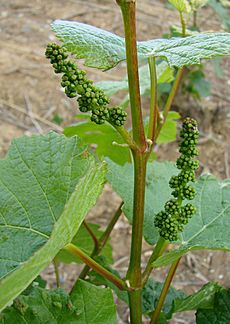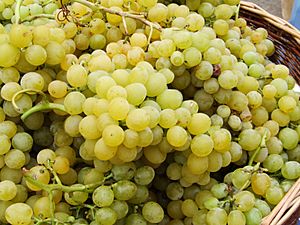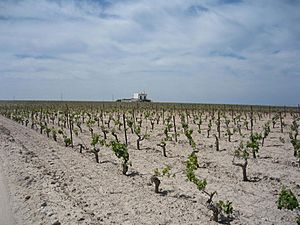Grapevine facts for kids
Quick facts for kids Grapevine |
|
|---|---|
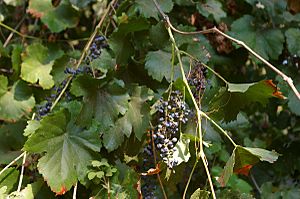 |
|
| Vitis californica with fruit | |
| Scientific classification |
|
| Kingdom: | Plantae |
| Clade: | Tracheophytes |
| Clade: | Angiosperms |
| Clade: | Eudicots |
| Clade: | Rosids |
| Order: | Vitales |
| Family: | Vitaceae |
| Subfamily: | Vitoideae |
| Genus: | Vitis L. |
| Type species | |
| Vitis vinifera |
|
| Species | |
|
List
V. acerifolia
V. aestivalis |
|
Vitis is the scientific name for grapevines. These are climbing plants that belong to the flowering plant family called Vitaceae. There are about 79 different kinds, or species, of grapevines. Most of them grow in the northern parts of the world.
Grapevines are very important because they give us grapes! We eat grapes fresh, and they are also used to make wine. The study of growing grapevines is called viticulture.
Most grapevines grown today have flowers that can pollinate themselves. This means they have both male and female parts. Wild grapevines usually have separate male and female plants. These tiny flowers grow in groups called inflorescences. When the flowers are pollinated, they turn into grape berries.
Even though grapevine flowers are small, the berries often grow big and colorful. They are sweet, which helps attract birds and other animals. These animals eat the grapes and then spread the seeds, helping new grapevines grow.
Grapevines usually only grow fruit on new shoots. These shoots come from buds that formed during the previous growing season. This is why people who grow grapes often trim the old woody parts of the vine in winter. They cut the vines to leave either a long "cane" with many buds or a smaller "spur" with just a few buds.
Contents
What are Grapevines Like?
Grapevine flowers start as buds late in the year. They stay on the plant through winter and then bloom in the spring. The flowers grow in clusters opposite the leaves.
A special thing about Vitis flowers is that their petals stay joined at the top. They fall off together like a little cap. Most flowers have both male and female parts. The fruit is a juicy berry, usually shaped like an oval. Each berry can have up to four seeds inside.
Grapevines also have tendrils. These are like little arms that grow opposite the leaves. They help the plant climb by wrapping around things like tree branches or the wires of a support system.
In the wild, grapevines usually have separate male and female plants. But when people started growing them, they chose plants that had flowers with both parts. This made it easier to get fruit.
The Vitis group is split into two smaller groups. One group, Euvitis, has 38 chromosomes. Their grapes grow in large clusters. The other group, Muscadinia, has 40 chromosomes and smaller grape clusters.
Wild grapes can sometimes look like a plant called moonseed. Moonseed is poisonous, so it's important to know the difference!
Different Kinds of Grapes
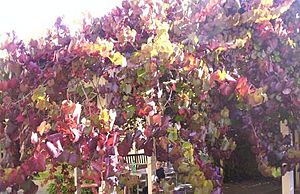
Most Vitis species grow in places with mild weather in North America and eastern Asia. One important type, Vitis vinifera, comes from southern Europe and southwestern Asia. Grape species grow in many different places and look very different from each other.
It can be hard to tell different species apart because their leaves can change shape. Mature grapevines can grow very thick, up to 48 centimeters (about 19 inches) wide. They can also climb very high, reaching the tops of trees more than 35 meters (about 115 feet) tall.
Many grape species are closely related. They can easily breed with each other and create new, strong types of grapes. This means that what we call a "species" might just be different kinds of Vitis that have grown in different places and conditions.
The exact number of Vitis species is not fully known. There are more than 65 species in Asia that are not clearly defined. About 25 species are found in North America. Only one, V. vinifera, comes from Europe and Asia.
Here are some notable types:
- Vitis aestivalis: This is the summer grape, found in the Eastern United States.
- Vitis amurensis: This grape grows in Asia, including parts of Siberia and China.
- Vitis arizonica: The Arizona grape is found in the southwestern United States and northern Mexico.
- Vitis berlandieri: This grape is from southern North America. It can grow well in soils with a lot of lime, which can be hard for other grapevines.
- Vitis californica: This is a wild grape found across much of California and parts of Oregon.
- Vitis coignetiae: This plant from East Asia is grown for its beautiful red leaves in autumn.
- Vitis labrusca: Also known as the fox grapevine, it's used for winemaking and jam. It's native to the Eastern United States and Canada. The Concord grape comes from this species.
- Vitis riparia: This is the riverbank grapevine, used for wine and jam. It grows across the Eastern United States and up into Quebec.
- Vitis rotundifolia: This grape is used for jams and wine. It grows in the Southeastern United States.
- Vitis rupestris: This rock grapevine is used to create rootstocks that are resistant to a pest called phylloxera. It's from the Southern United States.
- Vitis vinifera: This is the European grapevine, the most common type used for wine. It comes from the Mediterranean and Central Asia.
- Vitis vulpina: This frost grape grows in the Eastern United States.
There are many different kinds of grapevines that people have grown, called cultivars. Most of these are types of V. vinifera. One example is Vitis 'Ornamental Grape'.
Hybrid grapes are also common. These are crosses between V. vinifera and other types like V. labrusca. Hybrids are often stronger against cold weather and diseases. However, some hybrid wines might have a slightly different taste.
Grapevines and Their Environment
Phylloxera is a tiny bug, like an aphid, that lives on grapevine roots. In the late 1800s, this bug accidentally came to Europe from America. It caused huge damage to V. vinifera vineyards there.
People tried to breed grapes that could fight off phylloxera. But many winemakers and customers didn't like the taste of wine from these new hybrid vines. So, they found a solution: they started grafting V. vinifera vines onto the roots of American grape species. These American roots are naturally resistant to phylloxera. Today, most grapes grown for wine use these special rootstocks.
The black vine weevil is another bug that can harm grapevine roots. Grapevines are also a food source for the larvae (young forms) of some Lepidoptera species, which include butterflies and moths.
Growing Grapes Around the World
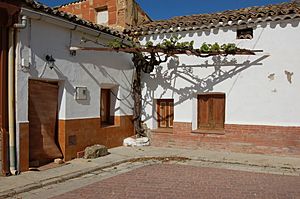
According to the UN's Food and Agriculture Organization (FAO), a huge area of the world, about 75,866 square kilometers (which is bigger than the country of Ireland!), is used to grow grapes.
About 71% of all grapes grown are used to make wine. About 27% are eaten fresh as fruit. The remaining 2% are dried to make raisins. Some grapes are also made into grape juice, which is used to sweeten canned fruits. The amount of land used for grapevines is growing by about 2% each year.
Here is a list of the top countries that grow grapes, showing how much land they use:
| Country | Area under vine (ha x103) | Grape production (metric ton x106) |
|---|---|---|
| World | 7511 | 75.7 |
| 1021 | 6.0 | |
| 830 | 12.6 | |
| 786 | 6.3 | |
| 682 | 8.2 | |
| 497 | 3.6 | |
| 419 | 7.0 | |
| 225 | 2.4 | |
| 223 | 2.1 | |
| 217 | ||
| 211 | 3.1 | |
| 192 | ||
| 149 | 1.7 | |
| 140 | ||
| 130 | 2.0 | |
| 120 | 2.6 | |
| 85 | 1.5 | |
| 60 | ||
| 39 |
Growing Grapes at Home
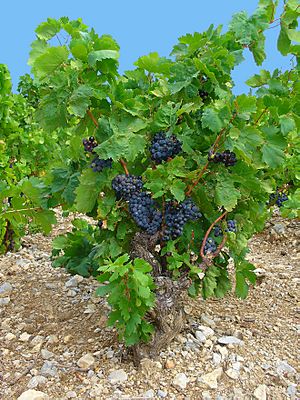
Many people grow grapevines in their gardens. These plants are popular because their leaves are beautiful, especially in autumn when they turn bright colors. They can also grow over walls, pergolas, and arches, providing nice shade. And, of course, they produce fruit! You can eat these grapes fresh or use them to make homemade wines.
Here are some popular types of grapevines for home gardens:
- 'Buckland Sweetwater' (white dessert grape)
- 'Chardonnay' (white wine grape)
- 'Foster's Seedling' (white dessert grape)
- 'Muscat of Alexandria' (white dessert grape)
- 'Müller-Thurgau' (white wine grape)
- 'Phoenix' (white wine grape)
- 'Pinot noir' (red wine grape)
- 'Regent' (red wine grape)
- 'Schiava Grossa' (red dessert grape)
- 'Seyval blanc' (white wine grape)
Some grape varieties have won the Royal Horticultural Society's Award of Garden Merit. This award means they are excellent plants for gardens:
- 'Boskoop Glory' (good for eating or wine)
- 'Brant' (black dessert grape)
- 'Claret Cloak' or 'Frovit' (grown for its looks)
- 'New York Muscat' (black dessert grape)
- 'Purpurea' (grown for its looks)
Uses of Grapes
The fruit from several Vitis species is grown to be eaten fresh or to be made into wine. Vitis vinifera is the most important type for this.
The leaves of some grapevine species are also edible! They are used in dishes like dolmades (stuffed grape leaves) and Vietnamese lot leaves.
Grapevines in Culture
The grapevine has been an important symbol for a very long time.
In Greek mythology, Dionysus was the god of wine. So, grapevines with bunches of grapes are often shown with him. The ancient Greeks and Romans would drink wine as an offering to this god.
Grapevines also have deep meaning in Jewish tradition. They are mentioned many times in the Hebrew Bible (Old Testament), along with grapes and wine. The grapevine is seen as a symbol of the Israelites. Wine is used in special Jewish rituals, like the Kiddush blessing on Shabbat and Jewish holidays. Ancient Jewish coins and synagogue decorations also feature grapevines.
In Christian iconography, the vine appears often too. It is mentioned in the New Testament. Jesus Christ said, "I am the true vine" (John 15:1). Because of this, the vine is a symbol of Jesus. You can see grapevines and grapes in old mosaics and on religious objects. They often represent the bread and wine used in the Eucharist, which symbolize the body and blood of Christ.
See also
 In Spanish: Vid para niños
In Spanish: Vid para niños


